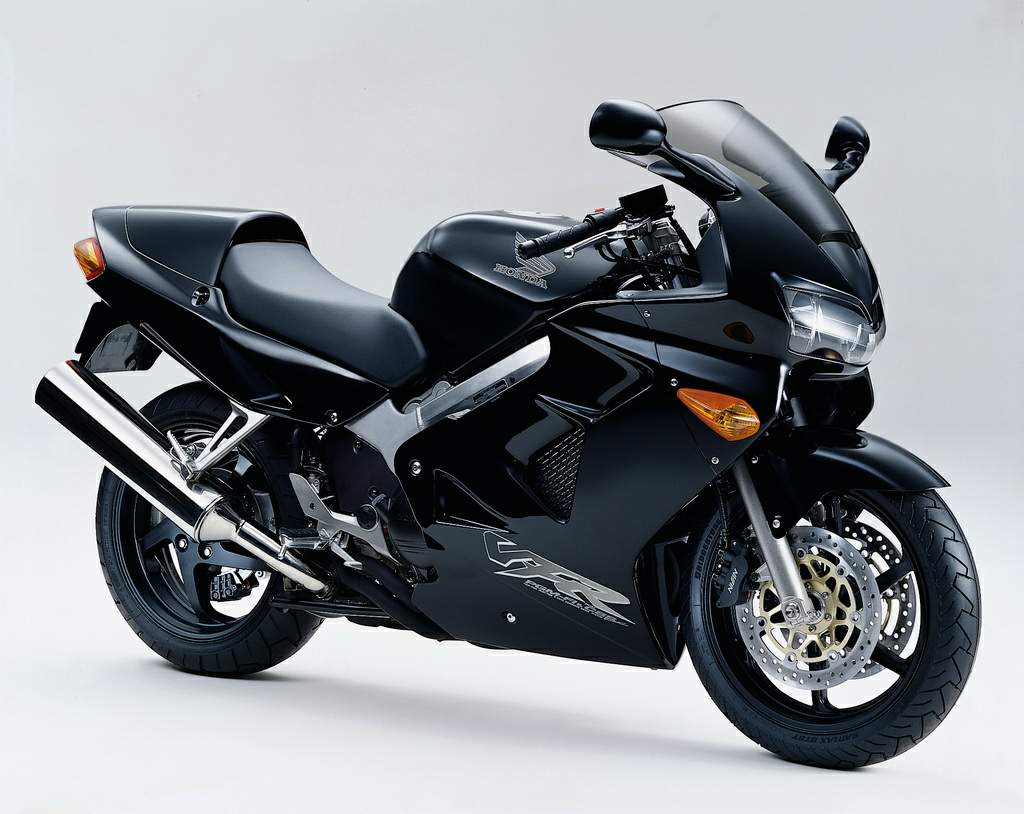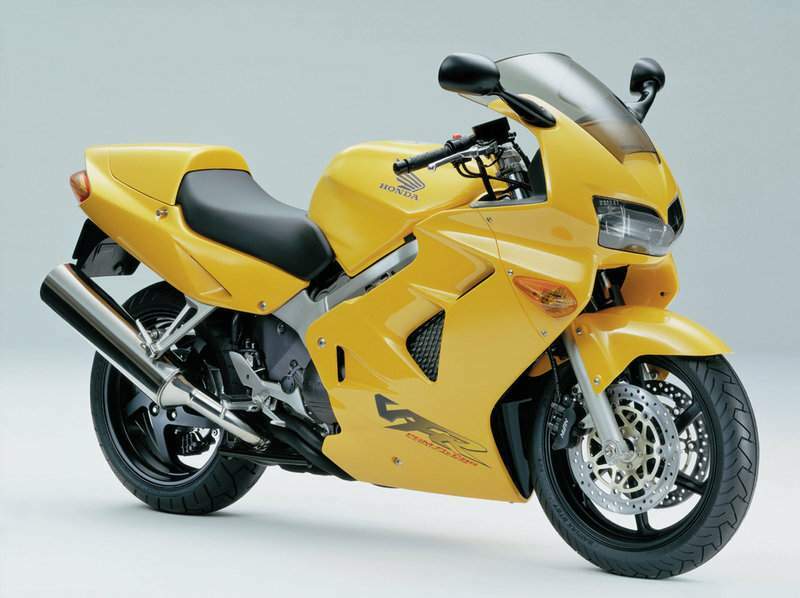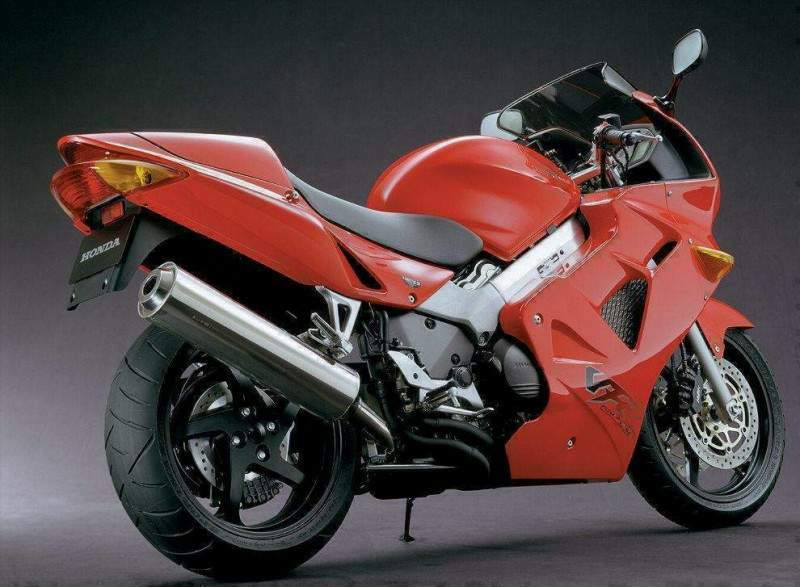
|
|
|
|
|
|
Classic Bikes
Custom Bikes
Individual
Racing Bikes AJP
AJS
Aprilia
Ariel
Avinton / Wakan
Bajaj
Benelli
Beta
Bimota
BMW
Brough Superior
BRP Cam-Am
BSA
Buell / EBR
Bultaco
Cagiva
Campagna
CCM
CF Moto
Combat Motors
Derbi
Deus
Ducati
Excelsior
GASGAS
Ghezzi Brian
Gilera
GIMA
Harley Davidson
Hero
Highland
Honda
Horex
Husaberg
Husqvarna
Hyosung
Indian
Jawa
Kawasaki
KTM
KYMCO
Laverda
Lazareth
Magni
Maico
Mash
Matchless
Mondial
Moto Guzzi
Moto Morini
MV Agusta
MZ / MuZ
NCR
Norton
NSU
Paton
Peugeot
Piaggio
Revival Cycles
Roland Sands
Royal Enfield
Sachs
Sherco
Sunbeam
Suzuki
SWM
SYM
Triumph
TVS
Ural
Velocette
Vespa
Victory
Vincent
VOR
Voxan
Vyrus
Walt Siegl
Walz
Wrenchmonkees
Wunderlich
XTR / Radical
Yamaha
Zero
Video
Technical
Complete Manufacturer List
|
Honda VFR 800Fi |
| . |
|
Make Model |
Honda VFR 800Fi |
|
Year |
1998 |
|
Engine |
Four stroke, 90°V-four cylinder, DOHC, 4 valve per cylinder |
|
Capacity |
781.7 cc / 47.7 cu-in |
| Bore x Stroke | 72 x 48 mm |
| Cooling System | Liquid cooled |
| Compression Ratio | 11.6 1 |
| Lubrication | Wet sump |
| Engine Oil | Semi-Synthetic, 10W/40 |
|
Induction |
PGM-FI electronic fuel injection |
|
Ignition |
Digital transistorized with electronic advance |
| Spark Plug | NGK, CR9EH-9 |
| Starting | Electric |
|
Max Power |
110 hp / 81 kW @ 10500 rpm |
|
Max Power Rear Tyre |
101.6 hp @ 9600 rpm |
|
Max Torque |
82 Nm / 60.4 lb-ft @ 8500 rpm |
| Clutch | Wet, multiple discs |
|
Transmission |
6 Speed |
| Final Drive | #530 O-ring-sealed chain |
| Frame | Aluminium, twin spar |
|
Front Suspension |
41mm H.M.A.S. cartridge-type telescopic fork with preload adjustable damper |
| Front Wheel Travel | 120 mm / 4.7 in |
| Rear Suspension | Pro arm mono arm system incorporating stepless rebound-adjustable gas-charged H.M.A.S. damper with pro-link |
| Rear Wheel Travel | 120 mm / 4.7 in |
|
Front Brakes |
2x 296mm discs 3 piston calipers |
|
Rear Brakes |
Single 256mm disc 3 piston caliper |
| Front Wheel | 3.5 x 17 in |
| Rear Wheel | 5.5 x 17 in |
|
Front Tyre |
120/70 ZR17 |
|
Rear Tyre |
180/55 ZR17 |
| Rake | 25.5° |
| Trail | 100 mm / 3.9 in |
| Dimensions |
Length 2120 mm / 83 in Width 735 mm / 28.9 in Height 1195 mm / 47.0 in |
| Wheelbase | 1440 mm / 56.7 in |
| Seat Height | 805 mm / 31.7 in |
|
Dry Weight |
208 kg / 458.6 lbs |
|
Fuel Capacity |
20.8 Litres / 5.5 US gal |
|
Consumption Average |
15.9 km/lit |
|
Braking 60 - 0 / 100 - 0 |
13.0 m / 37.9 m |
|
Standing ¼ Mile |
11.1 sec / 193.0 km/h |
|
Top Speed |
235.1 km/h / 146 mph |
|
Road Test |
Cycle World |
| . |
The VFR Honda has a fanatical following of enthusiasts who simply would not ride anything else.
Is it the balance between cruising, touring or fanging?
Is it the truly fantastic note of the V-Four engine when fitted with a more open pipe?
Or is it the whine of the gear driven cams?
I honestly don't know what it is that makes VFR riders about as one-eyed as they come but I do know they have some good reasons to be happy.
My main reason for liking the VFR is the engine note, especially when fitted with a pipe. It gets even better when you remove the snorkel that is slotted into the top of the airbox. This opens up the breathing a bit more and makes the induction growl deep and raucous. A corresponding increase of between 0.5 and 1.2 horsepower is also gained throughout the rev-range, the power gain doesn't make the removal worth it, the noise does.
The engine is pretty good but could do with more at the top-end for a bit more added excitement. It is a grunty unit through the mid-range though and wheelies are very easily controlled using the excellent throttle response. I feel that the engine would be more than enough for most people looking to buy into this class of bike, while I am not so easily satisfied. This is more of a reflection on my tastes, which most people would probably call a bit strange, rather than a criticism of the Honda. Throttle response, however is unparalleled.
The connection between your right hand and the back wheel is fairly instantaneous with the fuel injection system being the best I have sampled. Some say it is too direct, personally I just think that they must just be a little ham fisted, I wish all bikes had such a great throttle response.

The dash layout is great with ambient air temp, engine temp, two tripmeters, odometer and fuel gauge. This combination puts some cars to shame.
The VFR does handle reasonably well but is handicapped by it's 235 kilo wet weight. The older model VFR's are a bit more chuckable in tighter going.
The linked brakes are quite good on the more high speed stuff but become a bit of a hassle in the very tight stuff. I never feel quite safe not having complete control of the front and rear brakes independently while negotiating slow, tight corners. The latest generation linked brakes are excellent however when the speeds go up and all your braking is done in a straight line.
The build quality is very good and if you don't change bikes very often the VFR will keep looking good for a long, long time. It would pay to maybe apply a thin sheet of contact to the area around the light while on longer journeys out of the city. The paint seems to be a little too easily chipped by any debris that finds its way up around the upper part of the front fairing, just below the screen.
The screen does work quite well, but its performance is degraded to an appreciable factor by the addition of a tankbag, which seems to disturb the airflow to a more uncomfortable degree. The older generation of VFRs were better in this regard I feel.

The great fuel injected engine is the main reason anyone would consider upgrading from a mid 90s VFR, and it is a great improvement. Not so much in the outright numbers it makes but the seamless and smooth delivery of the power when using that great throttle action.
I have covered around 20,000 kilometres on the latest generation VFR and around 4000 kilometres on the previous model so I should know its strengths and weaknesses fairly well.
It is nearly criminal not to put a pipe on the VFR and let it sing its glorious V-Four song.
The VFR is a $15,000 ask, a little cheaper than it's main rivals in this touring-sports class. I prefer to class bikes like the R1100S, Sprint ST, Ducati ST2, ST4 and VFR as touring-sports rather than sports-touring. That gap has been filled by Kawasaki's ZX9R Ninja and the Honda VTR 1000 Firestorm among others.
Some people criticise the VFR and its Japanese stable mates of not having soul.
While this may be true of some offerings currently in the marketplace, it can't be said of the VFR. If you don't feel anything when riding it, ditch that intake snorkel, fit an open pipe and prepare your senses for the aural rush that will accompany your next ride.
Source MCNews.au

|
Any corrections or more information on these motorcycles will be kindly appreciated. |